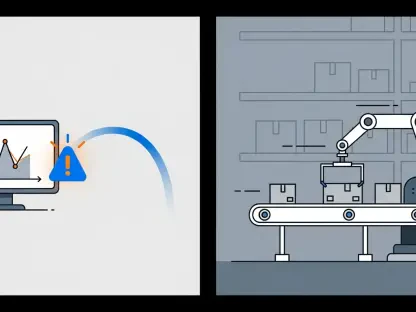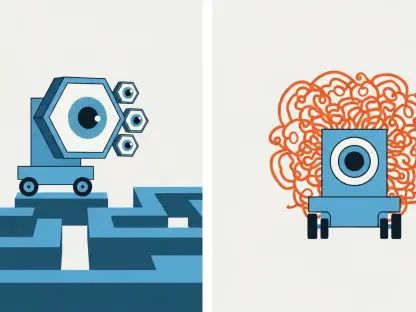Artificial intelligence (AI) continues to revolutionize multiple sectors, yet the intricacies of human cognition pose significant challenges in developing systems that truly comprehend human concepts. A recent study published in the journal Nature Human Behaviour sheds light on AI’s limitations in representing human understanding of concepts such as flowers. The research, led by Qihui Xu, scrutinizes how large language models (LLMs), despite their formidable capabilities in processing linguistic data, fall short of capturing the depth of human cognitive experiences. This examination underscores a fundamental issue within AI technology: the inability to mimic the sensory and motor interactions integral to human concept comprehension.
The Complexity of Human Versus AI Cognition
Understanding Through Sensory and Motor Experiences
Human cognition is characterized by an intricate blend of sensory, motor, and emotional experiences, creating a sophisticated tapestry of understanding. When interacting with something as simple as a flower, individuals not only rely on sight and language but also incorporate smell, touch, and spatial interactions, facilitating a richer, multidimensional comprehension. AI models like ChatGPT lack these sensory and motor experiences, limiting their grasp of such concepts. While AI can access and process an extensive amount of text data, it remains devoid of the experiential components that humans naturally integrate. This gap highlights AI’s intrinsic limitation; its understanding is confined to abstract data, devoid of the experiential richness inherent in human thought processes.
AI’s Abstract Processing Limitations
The disparity between human and AI cognition becomes glaringly apparent when considering the sensory-motor and emotional richness humans attach to their experiences. AI models excel at processing massive amounts of data, achieving feats unimaginable by humans in terms of volume. However, they fall short in grasping the emotional and sensory nuances that humans naturally imbue into their comprehension of the world around them. For instance, while an AI model can parse textual descriptions of a rose, it misses the experiential act of smelling the rose, touching its petals, and appreciating its presence. This abstract approach to processing data signifies a crucial gap between AI’s capabilities and human comprehension, suggesting a necessary pivot in AI research to incorporate experiential modalities.
Bridging the Cognitive Divide
Multimodal Inputs and AI Progress
The study indicates an emerging acknowledgment within AI and cognitive sciences of the imperative role multimodal inputs play in understanding human cognition more comprehensively. Researchers emphasize that LLMs notably underperform in capturing concepts closely tied to sensory and motor experiences. For example, AI may understand ‘rose’ linguistically but fails to represent the sensory interaction experienced by humans. The realization among experts stresses the necessity to integrate modalities beyond text and visuals to mirror human understanding accurately. By focusing on enhancing AI systems with multimodal data inputs, it may be feasible to bridge the existing cognitive divide and approach a more human-like understanding in AI processing.
Examining Human and AI Cognitive Alignment
The study further explores the partial alignment of AI and human cognition when examining non-sensorimotor words—concepts not heavily contingent on sensory or motor interactions. Here, LLMs show a moderate ability to replicate human understanding, albeit restricted to domains where linguistic input suffices. This observation reveals that while AI can simulate human cognition in certain areas, it exposes the limitations inherent in its design concerning sensorimotor-related concepts. Synthesizing these findings, the study demonstrates that current AI systems are inherently restrictive due to their reliance on text, pointing to a significant area of research needed to reconcile the experiential gap between AI and human comprehension.
Sensorimotor Challenges in AI Models
Test Outcomes and Human Versus AI Ratings
The study employed two metrics—the Glasgow Norms and Lancaster Norms—when testing human participants alongside LLMs from OpenAI and Google, examining concepts tied to sensory experiences. The Glasgow Norms required participants to rate words based on emotional arousal and imageability, while Lancaster Norms evaluated the connections between concepts and sensory-motor dimensions. Findings revealed that humans demonstrate a more cohesive and nuanced conceptual understanding, naturally linking various sensory experiences into unified categories. In contrast, LLMs, relying solely on linguistic data, consistently failed to emulate this emotionally and tangibly rich comprehension inherent to human cognition. The results clearly show how the inability of AI to handle sensorimotor word connections remains a significant barrier to achieving human-like understanding.
Recognizing the Representation Gap
The knowledge representation gap between humans and AI is evident, particularly concerning words deeply rooted in sensory experiences. This limitation is described as a considerable obstacle preventing LLMs from replicating the genuine breadth and depth of human understanding. AI’s dependence on text-based learning underscores its inability to address concepts intertwined with human senses and interactions effectively. By failing to capture the multidimensional aspects of human cognition, AI remains detached and abstract in its processing capacities. The study’s findings challenge AI developers to consider integrating sensory and motor experiences within AI systems to advance toward models capable of more accurately replicating human conceptual understanding.
Exploring Future Prospects for AI
Integration of Sensory Data and Robotic Capabilities
With AI advancing rapidly, the potential inclusion of sensory data and robotic capabilities might transform future LLMs, equipping them with the means to engage actively with the physical world. Such advancements could discernibly bridge the gap between human and machine understanding, allowing AI systems to represent human concepts more closely. The prospect of incorporating sensory modalities presents a promising frontier in AI development, likely to enhance interaction between AI and humans, fostering more integrated applications across various domains. These advancements might prompt a shift toward holistic, multidimensional AI models engineered to understand human cognition’s complexity and richness more authentically.
Paradigm Shifts in AI Model Design
The article accentuates the necessity for paradigm shifts in AI model design, turning toward systems imbued with the ability to replicate the sensory and emotional dimensions of human experience effectively. By integrating broader inputs beyond text and visual data, AI could achieve a more authentic interaction with human users, creating systems capable of processing intricate human concepts with improved fidelity. This vision suggests moving towards developing AI that genuinely understands and represents human cognition through enriched interaction channels that mirror human experiences more closely. Future advancements could pave the way for AI systems to facilitate richer engagements between technology and daily human life, aligning more closely with human cognitive processes.
Building Cognitive Bridges in AI
Multidimensional Models and Their Applications
The exploration insists on moving beyond textual processing, advocating for AI models that incorporate various data modalities to capture human concepts comprehensively. Multidimensional models equipped with the ability to interact with and infer from sensory inputs could redefine AI’s role in everyday interactions, enhancing its capability to understand and predict human behavior and preferences accurately. The practical applications of such models are immense—from enhancing AI-driven personal assistants to optimizing robotics that can navigate human-centric environments seamlessly. These advancements could fortify AI’s integration into daily life, making it a more adept companion that understands and adapts to human needs dynamically.
Pathways to Enrich Human-AI Interaction
Artificial intelligence (AI) is transforming various sectors, yet the complexities of human cognition present significant hurdles in creating systems that truly grasp human concepts. A recent study published in Nature Human Behaviour highlights AI’s limitations in effectively representing human understanding of concepts, such as flowers. Led by Qihui Xu, the research investigates how large language models (LLMs)—despite their impressive linguistic processing capabilities—struggle to fully capture the richness of human cognitive experiences. This study reveals a core issue within AI technology: it lacks the ability to replicate the sensory and motor interactions essential for human concept comprehension. While AI can handle vast amounts of data, it doesn’t necessarily equate to understanding the nuanced, multi-sensory experiences humans use to comprehend their environment. Thus, although AI advances rapidly, bridging the gap between machine processing and genuine human-like understanding remains a key challenge.









